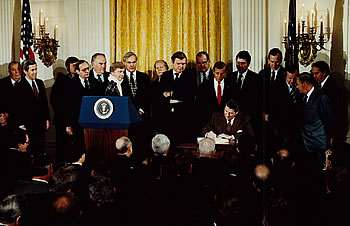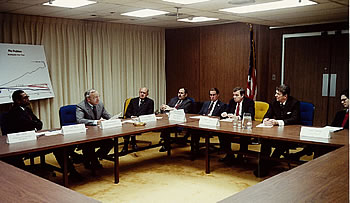30 Years Ago: President Ronald Reagan Visits DOT Headquarters: The Fight for a Gas Tax Increase
By Richard Weingroff
The country is in a recession with an unemployment rate as high as 10 percent! Highway and bridge needs far exceed highway user tax revenue! The President opposes a gas tax increase! Sounds familiar, but the year was 1982 and the solution was the Surface Transportation Assistance Act of 1982.

President Reagan signs the STAA in 1982.
In early 1982, the country was in a recession with high unemployment and inflation. Many States had been unable to keep up with maintenance needs on aging highways and bridges. Our "crumbling infrastructure," particularly aging bridges, had become a national crisis.
In discussions within the Reagan Administration, Secretary of Transportation Drew Lewis advocated a 5-cent increase in the 4-cent gas tax to provide additional revenue for needed highway and bridge improvements. The President had advocated user fees, such as the highway user taxes credited to the Highway Trust Fund, so that those who benefit from a government service would pay for them, but he was not willing to support an increase in the gas tax at the time.
Instead, the Administration was developing a New Federalism proposal to reduce the more than 500 categorical programs that had developed throughout the government over the years. In his January 1982 State of the Union Address, President Ronald Reagan said, "Let's solve this problem with a single, bold stroke: the return of some $47 billion in Federal programs to State and local government, together with the means to finance them and a transition period of nearly 10 years to avoid unnecessary disruption." He added:
I will seek no tax increases this year, and I have no intention of retreating from our basic program of tax relief. I promise to bring . . . tax rates down and to keep them down, to provide the incentives to rebuild our economy, to save, to invest in America's future. I will stand by my word.
Although hope for a gas tax increase appeared to be dead, the President authorized Secretary Lewis to reach out to transportation interests and Congress to explore support for the idea. Lewis and Federal Highway Administrator Ray A. Barnhart took advantage of this clearance to do just that.
One opportunity came on January 12, 1982, when President Reagan visited the Department of Transportation Headquarters at 400 Seventh Street, SW, in Washington to address the Department's Senior Executive Service. He told them that, "good tax policy is one in which, as much as possible, the tax that funds a service is levied on those who benefit from the service." He thanked the executives for their "leadership in developing the transportation user-fee concept [which] will more equitably distribute the cost of transportation among those who actually benefit."
While in the building, the President met with Secretary Lewis, his top assistants, and the heads of the Modal Administrations, including Administrator Barnhart. During the meeting, Barnhart made the case for a user tax increase to address the deteriorating condition of the Nation's highways and bridges.

Administrator Ray Barnhart explains to President Reagan the need for additional revenue.
The text of his remarks is not available, but Barnhart summarized his views in the May 1982 issue of FHWA News. The Nation, he said, was at a critical stage "where increased expenditures are going to be necessary to prevent further deterioration of one of our Nation's most vital economic and structural assets." The proposal under consideration was a 5 cent a gallon increase, totaling $5 billion a year, with one penny (or $1 billion) reserved for transit. Some people might think the diversion to transit inappropriate, but Barnhart said, "I believe the time has come for us to recognize that highways and transit are inseparable—the two modes are interdependent and complementary."
Pressure for a gas tax increase would continue through the year, but did not yield results until after the off-year elections on November 2. By the end of the month, the President had joined with Speaker of the House Thomas P. (Tip) O'Neill, Jr. (D-Ma.) and Senate Majority Leader Howard H. Baker, Jr. (R-Tn.) in seeking approval of a 5 cent a gallon gas tax increase during the post-election lame-duck session of Congress. The President explained his support by saying:
Our country's outstanding highway system was built on the user fee principle—that those who benefit from a use should share in its cost. It is appropriate that we rely on this same concept now. America has been blessed over the years with excellent transportation, and this program would provide us with a means of protecting and preserving this system.
On January 6, 1983, President Reagan signed the Surface Transportation Assistance Act (STAA) of 1982 in a ceremony in the State Dining Room at the White House. He said:
Today . . . America ends a period of decline in her vast and world-famous transportation system . . . . [We] can now ensure for our children a special part of their heritage—a network of highways and mass transit that has enabled our commerce to thrive, our country to grow, and our people to roam freely and easily to every corner of our land.
The new law would bring relief to those seeking work, the President said, but "its principal benefit will be to ensure that our roads and transit systems are safe, efficient, and in good repair." This was important because "our transportation system affects our commerce, our economy, and our future."
The 1982 STAA retained the basic structure of the Federal-Aid Highway Program while increasing overall revenue. It also created a Mass Transit Account in the Highway Trust Fund with 1 cent of the gas tax increase reserved for capital mass transit projects.
By the mid-1980s, the additional highway revenue translated into measurable improvements in the Nation's roads and bridges, particularly on the Interstate System. For the first time since the gas shortages of the early 1970s, the Nation could improve roads and bridges faster than they were aging.
(For a more detailed account, see "Palace Coup: President Ronald Reagan and the Surface Transportation Assistance Act of 1982" by Richard F. Weingroff at https://www.fhwa.dot.gov/highwayhistory/reagan_staa.cfm.)

